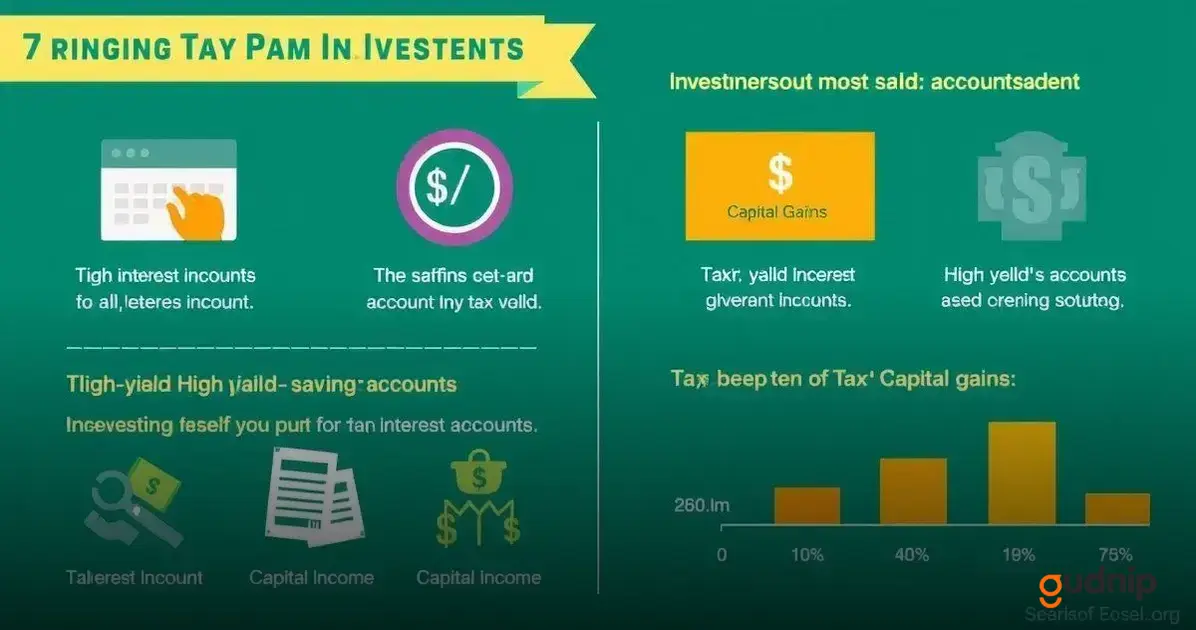Are you torn between choosing high-yield savings vs. investments for your financial future? It’s a common dilemma.
Both options have unique benefits and drawbacks that can significantly impact your savings and growth strategies.
Understanding High-Yield Savings Accounts
A high-yield savings account is a special type of savings account that offers a higher interest rate compared to traditional savings accounts.
This means that your money can grow faster while remaining relatively safe.
These accounts are often offered by online banks and credit unions, which can provide better rates than traditional brick-and-mortar banks.
How High-Yield Savings Accounts Work
High-yield savings accounts work by allowing you to deposit money just like any bank account.
The major difference is that they usually offer interest rates significantly higher than the national average.
Your money grows based on the interest rate, compounded regularly, often daily or monthly.
Pros of High-Yield Savings Accounts
One of the main benefits of a high-yield savings account is liquidity. This means you can quickly access your funds whenever you need them without penalties.
Additionally, these accounts are typically insured by the FDIC, meaning your deposits are protected up to a certain amount, adding an extra layer of security to your savings.
Cons of High-Yield Savings Accounts
While they offer many benefits, high-yield savings accounts may also have drawbacks.
For instance, some accounts require a minimum balance to earn the higher interest rate, while others might have fees that can eat into your savings.
It’s important to read the terms and conditions carefully before opening an account.
Comparing to Traditional Savings Accounts
When you compare high-yield savings accounts to traditional savings accounts, the differences are clear.
Traditional accounts usually provide lower interest rates, which means your savings grow slower.
Depending on where you keep your money, this can lead to a significant difference in returns over time.
When to Use a High-Yield Savings Account
These accounts are ideal for short-term savings goals or an emergency fund.
If you need to save money for a vacation, a new car, or future expenses, a high-yield savings account can help your money earn more while remaining easily accessible.
In Summary
High-yield savings accounts can be a smart choice for those looking for a safe place to grow their savings.
They offer higher interest rates, liquidity, and FDIC insurance, making them an attractive option compared to traditional savings accounts.
Always compare options to find the best account for your needs.
The Mechanics of Investment Options
Understanding the mechanics of investment options is crucial for anyone looking to grow their wealth.
Investments can come in many forms, including stocks, bonds, mutual funds, and real estate.
Each type of investment has its own unique characteristics, risks, and rewards.
Types of Investment Options
Stocks represent ownership in a company. When you buy stocks, you effectively buy a small piece of that company.
If the company performs well, the stock price can rise, leading to potential gains. However, stocks can also lose value, making them riskier.
Bonds are loans you give to governments or corporations in exchange for interest payments.
They are generally considered safer than stocks.
When you purchase a bond, you expect to receive periodic interest payments and get your principal back when the bond matures.
Mutual funds pool money from multiple investors to purchase a diversified portfolio of stocks and bonds.
This allows investors to spread their risk. When you invest in a mutual fund, you may pay management fees, which can affect your overall returns.
Real estate refers to investing in property. This can be residential homes or commercial buildings.
Real estate can provide rental income and appreciation in value, but it also requires ongoing maintenance and management.
Understanding Risk and Return
All investments carry some level of risk. Generally, the higher the potential return, the higher the risk.
For example, stocks may have high returns but can also experience significant losses. In contrast, bonds may have lower returns with less volatility.
How to Choose an Investment Option
When deciding on an investment option, consider your financial goals, risk tolerance, and investment timeline.
Short-term investors may prefer safer options, while long-term investors might take on more risk for potentially higher returns.
Working with Financial Advisors
If you’re unsure about where to invest, consider consulting a financial advisor.
They can help you assess your situation and guide you in making informed investment choices that align with your goals.
Risk vs. Reward in Savings and Investments

In the world of finance, risk vs. reward is a crucial concept to understand.
This principle explains how higher potential returns on an investment often come with an increase in risk.
When you look at savings accounts and investments, it is important to weigh the balance between the two.
Understanding Risk
Risk refers to the chance of losing some or all of your investment. Savings accounts, especially high-yield ones, typically come with very low risk.
Your money is usually insured by the FDIC, making it a safe place to store cash.
On the other hand, investments like stocks and mutual funds carry higher risks.
The value of these investments can fluctuate greatly due to market conditions.
While you can potentially earn significant returns, there is always the possibility of losing money as well.
The Role of Reward
Reward is the potential profit earned from an investment.
In high-yield savings accounts, the reward is the interest you earn, which is generally modest.
It provides a safe return on your deposit without much risk.
Investments can offer much higher rewards compared to savings.
For instance, over time, the stock market has historically provided returns that significantly outpace inflation.
This makes investing an attractive option for long term wealth growth, although it requires accepting higher risks.
Finding the Right Balance
When making financial decisions, consider your financial goals and risk tolerance.
If you’re looking for short-term savings or low-risk options, high-yield savings accounts are a great choice.
If your goal is to grow your wealth over the long term and you’re comfortable with market fluctuations, diversifying your investments can lead to greater rewards.
Strategies for Managing Risk
To manage risk effectively, consider diversification. Spreading your investments across various asset classes can help reduce volatility.
Additionally, regularly reviewing your portfolio can ensure that your assets align with your risk appetite and financial goals.
Potential Returns: Savings vs. Investments
When it comes to potential returns, savings accounts and investments offer very different outcomes.
Understanding these differences is key to making informed financial choices.
Returns from High-Yield Savings Accounts
High-yield savings accounts generally provide a fixed interest rate.
This means you’ll earn a specified percentage on your balance, which is often better than traditional savings accounts.
However, the overall returns are usually modest.
For example, if your high-yield savings account offers an interest rate of 1.5% per year, that means your $10,000 deposit would earn around $150 in interest over one year.
Returns from Investments
Unlike savings accounts, investments can vary widely in their potential returns.
Stocks, for instance, have historically provided average annual returns of about 7-10% after accounting for inflation.
If you were to invest that same $10,000 in stocks and achieve a 7% return, your investment could grow by $700 in one year.
However, it’s important to remember that the stock market can be unpredictable, and losses are also possible.
Comparing Average Returns
When comparing returns, it’s clear that investments generally hold the potential for much higher earnings than savings accounts.
However, this comes at the cost of greater risk. While savings accounts offer consistent and safe returns, investments can fluctuate significantly and may lead to losses.
Time Factor in Returns
The time period for which you invest your money also affects potential returns.
Savings accounts typically yield lower returns in the short term but are very secure.
In contrast, investments like stocks may take longer to show gains.
A long-term investment strategy often leads to greater returns, as the stock market tends to rise over time despite periodic drops.
Inflation Impact
Consider the impact of inflation on your returns.
While high-yield savings accounts provide a safe place for your money, the returns may not keep pace with inflation.
This means your purchasing power could actually decrease over time.
On the other hand, investments aiming for higher returns can potentially outpace inflation, preserving and growing your wealth.
Liquidity in High-Yield Savings and Investments
Liquidity refers to how quickly and easily an asset can be converted into cash without affecting its market price.
Understanding liquidity is key when comparing high-yield savings accounts and various investment options.
Liquidity in High-Yield Savings Accounts
High-yield savings accounts offer excellent liquidity. You can access your money at any time without penalties.
Most institutions allow you to transfer funds electronically or withdraw cash from ATMs easily.
This makes high-yield savings accounts ideal for short-term savings goals or emergency funds.
Liquidity in Investments
Investments, such as stocks and mutual funds, can vary widely in liquidity.
Most stocks are considered liquid assets because they can be sold quickly on the stock market.
However, selling investments may take time and might incur transaction fees. In some cases, if the market is down, you may have to sell at a loss.
Real Estate and Other Investments
On the other hand, physical assets like real estate are typically illiquid.
Selling a property can take months and involves additional costs, including real estate agent fees.
This low liquidity means that real estate isn’t suitable for funds you may need to access quickly.
Balancing Liquidity Needs
When choosing between high-yield savings and investments, consider your liquidity needs.
If you require fast access to your money, high-yield savings accounts are the better option.
For long-term growth, while accepting some liquidity risk, you might choose investments and develop a diverse portfolio to balance your financial objectives.
Evaluating Financial Goals
Your financial goals also influence your choice.
If saving for short-term objectives, such as a vacation or emergency fund, a high-yield savings account works best.
If you’re investing for your future, such as retirement, focus on investment options that align with your risk tolerance and time horizon.
Tax Implications for Savings and Investments

Understanding the tax implications for savings and investments is crucial for managing your finances.
While both savings accounts and investments can grow your money, they are taxed differently.
Tax on High-Yield Savings Accounts
Interest earned from high-yield savings accounts is considered taxable income.
This means that the interest you make is subject to federal and possibly state taxes.
When you file your taxes, you will receive a 1099-INT form from your bank if you’ve earned more than $10 in interest. You must report this income on your tax return.
Tax on Investments
Investments such as stocks, bonds, and mutual funds also have tax implications. The key is understanding capital gains.
If you sell an investment for more than you paid, the profit you earn is considered a capital gain.
Short-term capital gains (from investments held for one year or less) are typically taxed at your regular income tax rate.
Long-term capital gains (from assets held for more than a year) usually receive a lower tax rate, making long-term investing more tax-efficient.
Dividends and Taxes
Investments that pay dividends also have tax implications.
Qualified dividends are taxed at the lower capital gains tax rate, while ordinary dividends are taxed at your regular income tax rate.
It’s important to know how your investment income is classified to understand your tax obligations.
Tax-Advantaged Accounts
To mitigate tax liabilities, consider using tax-advantaged accounts like IRAs or 401(k)s.
Contributions to these accounts often reduce your taxable income in the year you contribute.
Additionally, investments in these accounts can grow tax-deferred until you withdraw the money in retirement.
Consulting a Tax Professional
Since tax laws can change and vary by location, it’s wise to consult a tax professional.
They can help you navigate the complexities of taxes on savings and investments, ensuring you maximize your returns while minimizing your tax burden.
When to Choose Savings Over Investments
Choosing between savings and investments can depend on your financial goals and situation.
Here are some key scenarios where you might want to choose savings over investments.
1. Short-Term Goals
If you have a financial goal in the near future, such as a vacation or buying a new car, high-yield savings accounts are a better option.
They provide quick access to your money without the risk of losing value.
2. Emergency Fund
Establishing an emergency fund is crucial.
Savings accounts are perfect for this purpose because they allow you to hold your funds securely while earning interest.
An emergency fund should be easily accessible for unexpected situations like medical emergencies or urgent home repairs.
3. Low Risk Tolerance
If you are uncomfortable with risk or have a low tolerance for market fluctuations, high-yield savings accounts might be better.
They offer stability and guaranteed returns without the potential losses associated with the stock market.
4. Building Financial Discipline
Saving money in a high-yield account typically encourages better financial habits.
You can automate transfers to save a portion of your income, thus cultivating discipline without worrying about market volatility.
5. Tax Considerations
Some people may prefer savings accounts for tax reasons. Interest from high-yield savings accounts is straightforward.
Unlike investments that may result in capital gains tax, interest is reported simply and doesn’t fluctuate as significantly.
6. When Interest Rates are High
During times when interest rates are elevated, high-yield savings accounts can become quite attractive.
The returns from savings can outpace some low-performing investments, making them a sound choice for your money.
Making Smart Financial Decisions
Making smart financial decisions involves careful planning and informed choices about your money.
Here are some tips to help you navigate between high-yield savings and investments.
1. Assess Your Financial Goals
Before deciding where to allocate your money, determine your financial goals.
Are you saving for a short-term goal, like a vacation or a new car? Or are you planning for long-term objectives, like retirement?
Understanding your timeline is key to making the right choice between savings and investments.
2. Understand Your Risk Tolerance
Everyone has a different comfort level with risk. Assess how much risk you are willing to take.
If you prefer stability and guaranteed returns, high-yield savings accounts might appeal to you.
However, if you are willing to take on more risk for potentially higher rewards, consider investing.
3. Diversify Your Portfolio
If you choose to invest, diversification is crucial.
Spreading your investments across various asset classes—such as stocks, bonds, and mutual funds—helps reduce risk.
This way, if one investment underperforms, others can help balance your portfolio.
4. Keep Emergency Funds Accessible
Before investing, ensure you have an emergency fund in place.
This is essential to cover unexpected expenses without having to dip into your investments.
A high-yield savings account is a great place to store your emergency funds, providing easy access to your money.
5. Regularly Review Your Financial Strategy
Financial situations can change, so regularly reviewing your financial strategy is important.
Adapt your savings and investment strategies as needed based on your goals, market conditions, and life circumstances.
6. Seek Professional Help if Necessary
If you’re unsure about making financial decisions, consider consulting a financial advisor.
They can provide expert advice tailored to your situation, helping you make smarter choices for your money.
In Conclusion: Finding the Right Balance for Your Money
Deciding between high-yield savings and investments comes down to your financial goals, risk tolerance, and liquidity needs.
High-yield savings accounts provide safety and easy access to funds, making them ideal for short-term goals or emergency savings.
On the other hand, investments offer the potential for higher returns and growth over time, but they come with increased risks.
Understanding the mechanics of both options can help you make informed decisions that align with your financial objectives.
Whether you choose to save or invest, the key is to regularly assess your financial strategy and adapt as needed.
With the right approach, you can effectively grow your wealth while ensuring financial security.
As you navigate your financial journey, consider seeking advice from professionals to enhance your understanding and confidence in making smart financial decisions.




